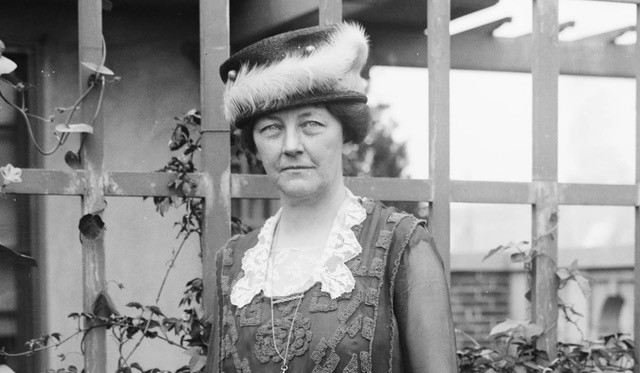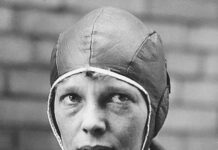
Yonkers resident Henrietta Livermore
By Mary Hoar, City of Yonkers Historian
Yonkers Mayor and suffrage advocate James Lennon spoke at a large Getty Square suffrage rally a few days before the election; he received a petition signed by hundreds of Yonkers women who wanted to vote.
November 6th, 1917, after a massive campaign by both women and men, voters passed an amendment to the New York State Constitution granting women full suffrage. The victory was carried overwhelmingly by New York cities; Yonkers was no exception. Only two election districts in Yonkers voted down suffrage, each district by just 8 votes.
New York, a milestone victory for the suffrage movement, had been an early focus of the suffragists; it remained the first and only eastern state to grant women full suffrage before national passage of the 19th Amendment.
Henrietta was not content to enjoy the glow of victory; she knew the fight was not over. Although the battle was won in New York, the rest of the country had to be convinced. She joined 100 members of the NY Woman Suffrage Party who interviewed President Wilson about his position on equal suffrage. Shortly after arriving home, the group marched in the New York City Suffrage Parade.
While continuing her fight, she continued and expanded her local work, uplifting the people of Yonkers. She remained involved in the Fairview Garden School, and founded a Yonkers branch of the Collegiate Periodical League; the group represented college women of America working on the home front in their effort to support their troops.
These women were tasked by the American Library Association to raise money to create libraries at all US training camps, to supply books and current magazine to camp libraries.
Wives of new citizens were entertained at a reception held at Woman’s Suffrage headquarters. The Yonkers Woman Suffrage Party became the Woman’s Council. The Council was open to all women who had an interest in government, especially as it pertained to voters and voting. They presented programs on topics such as “What women are entitled to enroll?”
Henrietta enrolled as a Republican, the party of her father, and was determined women be recognized as a part of the political process. As Chairman of the Republican Women’s Executive Committee of New York State, she urged women be allowed full membership in the party. A true politician, she stated, “Half a million women in this state have not enrolled with any party and to us as Republicans, they represent an opportunity.” Henrietta spoke at Republican rallies and meetings urging people to vote Republican.
True to their promise, suffragists didn’t forget our men overseas. The women continued working with the Red Cross; the St. Catherine’s Welfare Association suffrage group held a “monster euchre” to benefit the “boys of the Twelfth Regiment.” The workers continued doing whatever they could to “bring our boys back home.” Finally, the war was over.
In early 1920, the Republican State Committee selected two Yonkers people to represent them at the Republican National Convention in Chicago. They selected Colonel William Boyce Thompson as a delegate, and Mrs. Arthur Livermore as the alternate. She was one of three Yonkers delegates to the New York State Republican Convention in Carnegie Hall, along with Judge William Bleakley and C. Ray Cole A true sign of change, more than 100 women were elected to represent various districts in New York State at the state Republican convention in Saratoga.
To punctuate the importance of women becoming politically active in the Republican Party, Henrietta founded the National Women’s Republican Club in 1921. Not only was she the founder, she was its first president.
The Club established their National Headquarters in Manhattan, building a permanent home in 1934, the year after Henrietta passed away. Their new headquarters on West 51st Street was built on the site of Andrew Carnegie’s former New York home.
Another major 1921 event revolved around the election of son Russell to the New York State Assembly. One of his first acts in Albany was introduction of a bill ensuring women would be given equal representation to men on county political committees, amending NYS election law increasing (from one to two) the number of representatives from each election district. Henrietta by this point was the Chair of the Women’s Republican Committee, first woman Vice Chair of both the New York Republican State Committee and the Westchester County Republican Club.
In 1923, Henrietta Livermore of Yonkers introduced an update to the Republican State Executive Committee, calling for the State Committee to have equal representation for women. She won a major victory when it passed “without question” at it annual meeting. She immediately resigned as Chairman of the State Women’s Executive Committee, anticipating she would be elected to the new position of Vice-Chairman of the State Committee.
She wasn’t even close to being finished with her work!
Next: Henrietta Livermore: International American Representative!
Henrietta was serving as a member of the American Commission to the Brazilian Centennial exposition, appointed by President Warren G. Harding.
August 16, 1922: Rumors floating around Washington reached Yonkers, intimating Henrietta Livermore of Park Avenue was to resign from the American Commission to the Brazilian Centennial Exposition. No reason accompanied the gossip at the time. The Commission later was recalled to Washington by Secretary of State Hughes. It later came out Livermore and other members of the group fought for the removal of Frank Harrison, who was appointed Deputy Commissioner when Commissioner General D. C. Collier was away. Collier, Livermore and two other committee members wanted President Warren Harding to remove Harrison, claiming he falsified records and was wasting funds. Harrison made countercharges again her, which she strongly stated, were “totally unfounded and ridiculous.” Livermore was a leader of the New York State suffrage movement, founder of the Women’s National Republican Club, and close friend not only of President Harding, but also Presidents Coolidge and Hoover.
November 9, 1922: Carrying a greeting from President Warren G. Harding, Henrietta Livermore of 144 Park Avenue sailed for Brazil to attend the formal opening of the American Building in December.
August 20, 1922: Leader of New York State’s Republican women Mrs. Arthur Livermore of Park Avenue headed to Washington meet with Secretary of State Hughes a after a trip to Brazil as a member of the Brazilian Commission and received high praise on her report. She later had lunch at the White House with President and Mrs. Harding and National Republican Chairman John Adams.
August 23, 1922: Mrs. Arthur Livermore’s work as a member of the Brazilian Commission received high praise from Secretary of State Hughes when she made her report on her recent trip.
July 24, 1923: Mrs. Arthur Livermore of Park Avenue, a national Women’s Republican leader, went to a month-long conference on international policies in politics. The conference held in Williamstown, Massachusetts, covered questions on Mexico, Peru and Haiti.
August 25, 1923: Mrs. Arthur Livermore of Park Avenue, Deputy Commissioner General to the Brazilian Centennial Exposition, presented a paper on “Outstanding Problems of the American Continent” at the Institute of Politics at Williamstown Massachusetts.
September 7, 1923: After completing the four-week course on Latin American Republics at the institute of Politics in Williamstown, Massachusetts, Mrs. Arthur Livermore of Park Avenue, Yonkers, Livermore dropped into Washington DC to visit President and Mrs. Coolidge.
December 8, 1923: Henrietta Livermore, one of the leaders of the New York State Suffrage movement and founder of the National Women’s Republican Club, received a “handsome bronze medal,” awarded for her work as Commissioner at the Brazilian International Exposition.
By 1924, she was the State Republican Woman’s Executive Committee. That same year, she was feted at the Elks Club by more than 300 people, men and women, Republicans and Democrats, who paid tribute to her “spirit, intellect, and unselfish devotion to ideals of general betterment.” Women speakers particularly honored for her devotion to the cause of woman suffrage, and her faith that, in spite of all discouragements along the way, she did the smallest tasks as long as the prize of vote for all was won. One speaker who received loud cheers was former Public Safety Commissioner Thomas Tobin who carried a banner in suffrage parades before the vote was won.
January 19, 1925: Mrs. Arthur Livermore of Park Avenue embarked on a world tour to study foreign governments.
August 24, 1925: Park Avenue’s Henrietta Livermore was the Guest of Honor at a NYC luncheon celebrating the fifth anniversary of the women’s suffrage amendment.
May 16, 1927: More than 100 Yonkers women attended the luncheon meeting of the Westchester County Women’s Republic Club at the Hotel Commodore. Yonkers residents Mrs. Francis Winslow and Mrs. Arthur Livermore were the keynote speakers. Mrs. Livermore was the founder and first president of the organization.
February 1, 1928: Henrietta Livermore, political activist and suffragist, published the first of her series of articles on South America in The Yonkers Herald. Livermore had traveled to South America several times as an official government representative.
September 17, 1930: Mrs. Arthur Livermore, president of the Women’s National Republican Club, announced today that the organization was considering going on record in favor of the repeal of the 18th Amendment and the return to each state the powers to regulate the manufacture, sale and transportation of intoxicants.
April 15, 1931: Secretary of State Henry Stimson appointed Mrs. Arthur Livermore of Park Avenue as a member of the national Council of the Inter-American Institute of Intellectual Cooperation. Mrs. Livermore was a leader of the New York State Suffrage movement and president of the Women’s National Republican Club.
June 24, 1931: Mrs. Arthur J. Livermore of Yonkers, president of the Women’s national Republican Club, urged women to get involved in politics, asking them to “… put their minds to politics… to be of value to their country.” Mrs. Livermore, founder of the club, was one of the leaders of the women’s suffrage movement.
August 19, 1931: President Herbert Hoover entertained Mrs. Arthur Livermore of Park Avenue at an al fresco lunch on the south porch of the White House. Mrs. Hoover, called away by an important engagement, was not able to join them. Henrietta Livermore not only had been a leading suffragist in New York State, she was President and founder of the Women’s National Republican Club.
October 15, 1933: Henrietta Wells Livermore of Yonkers passed away. An outstanding leader, a national figure, and close friend of three presidents, she revitalized the New York State suffrage movement and later organized and headed the Women’s National Republican Club.
One of Henrietta Livermore’s passions was the National School of the National Women’s Republican Club; after her death, it was named in her honor.
This is a four part series on Livermore, which can all be found online at Yonkerstimes.com by searching her name





